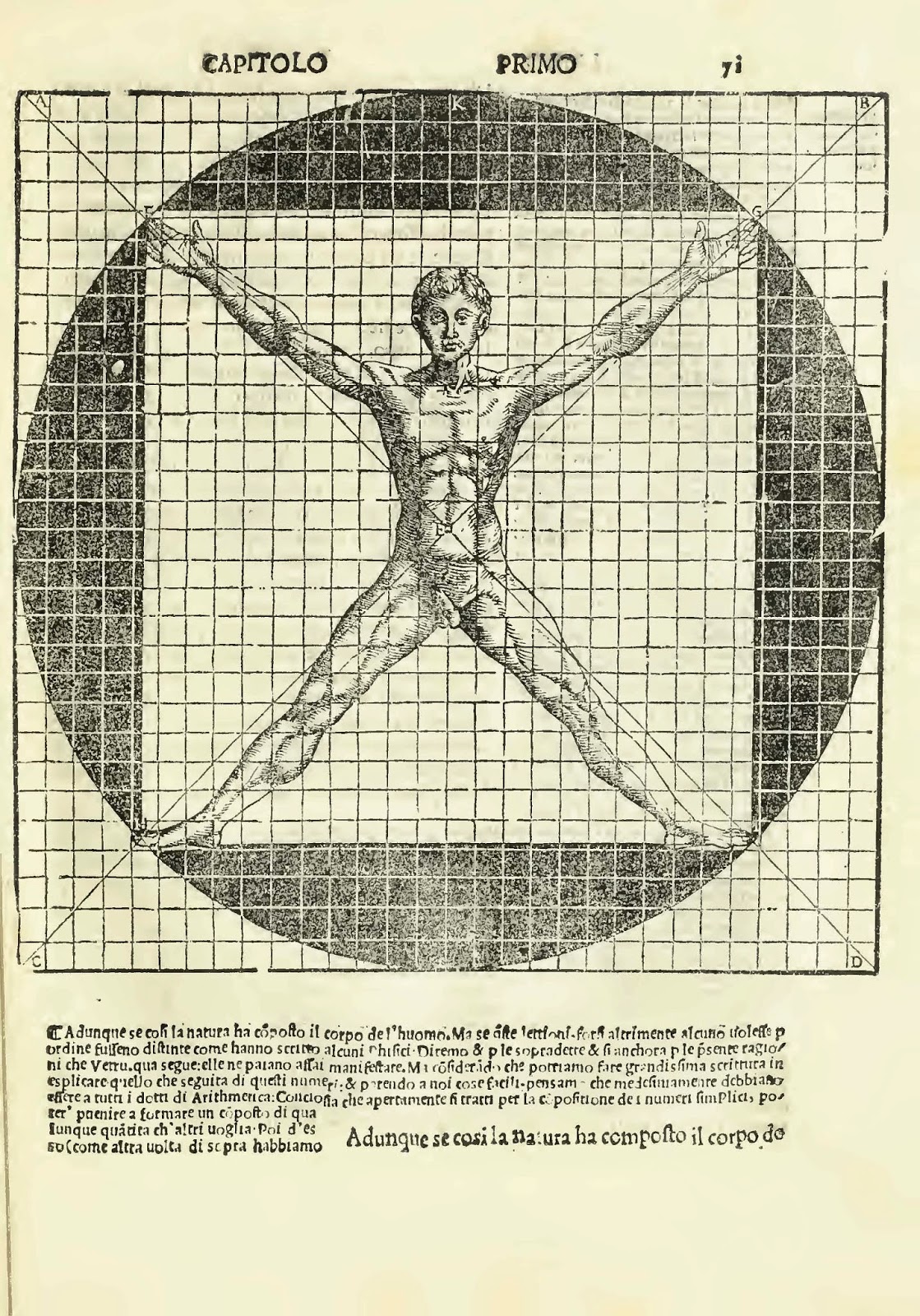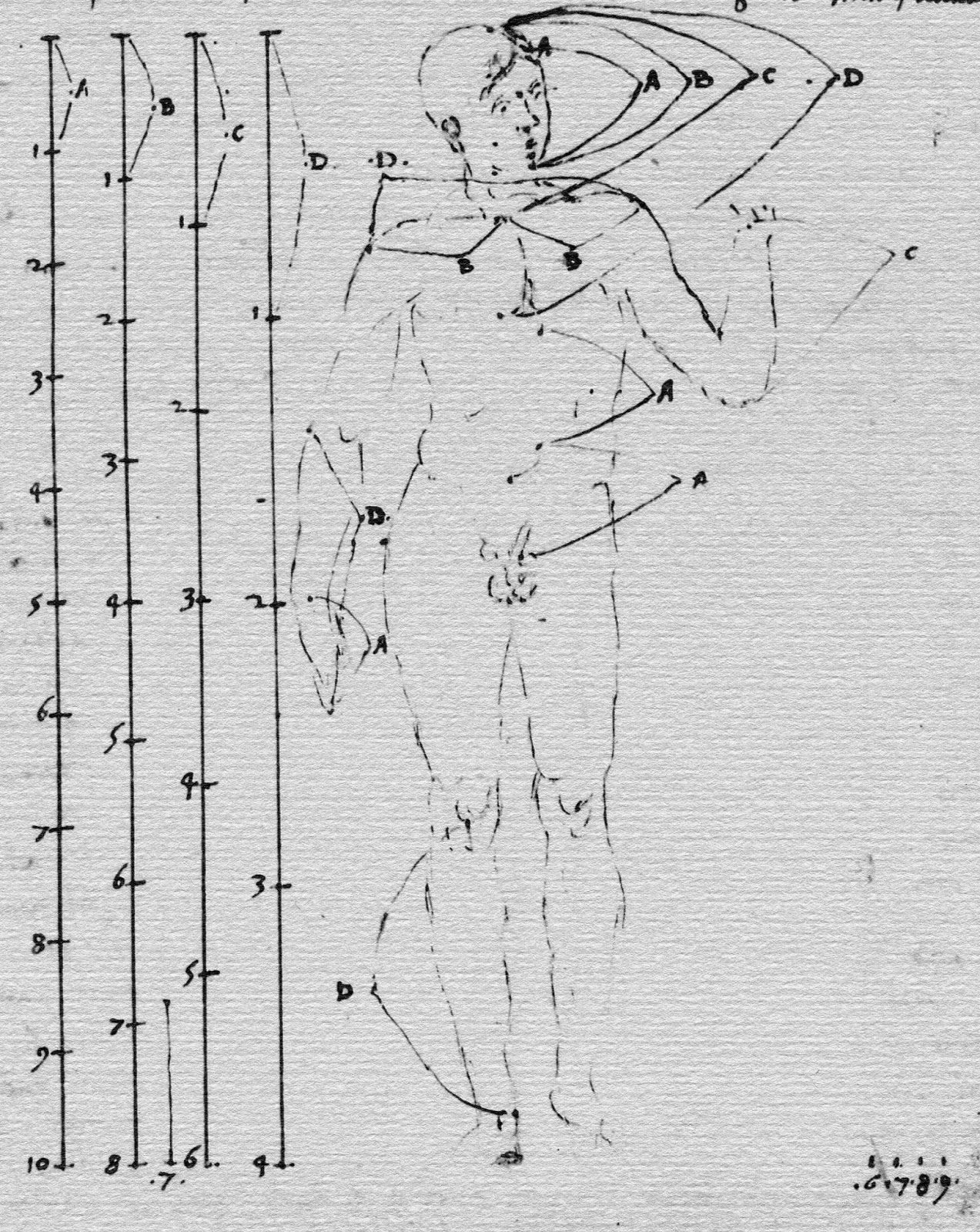Cesare Cesariano's Vitruvian Man from his translation of Vitruvius' De Architectura
Everyone is familiar with da Vinci's iconic sketch, The Vitruvian Man. The sketch is so famous, in fact, that by referring to the Vitruvian Man most people simply think of da Vinci, though there is a whole tradition of study around the geometry and proportions of the human body — da Vinci just so happened to have done an extraordinarily well done drawing of the geometry and proportions of the human body as described by Vitruvius. I have a significant digital collection of Vitruvian Men done by artists, architects, and scholars throughout the centuries, many predating da Vinci and many that came after him: Cesariano, Giocondo, di Giorgio, Taccola, Agrippa, Dürer, Fludd, Cataneo, Martin, Caporali, Barbaro, Sagredo, Le Corbusier, and the list goes on.
In all the Vitruvian Men I have found over the years there are three oddballs, namely Vitruvian Men that appear to have erections. Firstly there is one of Cesare Cesariano's Vitruvian Men — from his Italian translation of Vitruvius' De Architectura (the first instance of translating Vitruvius into a vulgar language), which he also illustrated with woodcuts — which depicts a man in a square, arms raised up and legs spread out so that the hands and feet touch the corners of the square, and then inside of a circle (pictured above). Cesariano's translation and illustrations were published in 1521. Upon close inspection one will notice that the penis appears erect.
Giovanni Caporali's Vitruvian Man
In 1536 a similar image (more than likely copied from Cesariano's) was produced and published by Giovanni Battista Caporali in a newly illustrated printing of De Architecture (but in Latin). This one, like Cesariano's appears to have an erect penis.
This type of posing of the human body with the legs spread and arms up inside of square is not unique, as Agrippa did a similar image in his Three Books of Occult Philosophy in 1533, but Agrippa's illustration does not have an erect penis. But there is a third Vitruvian Man by an anonymous writer — possibly a certain Giocomo Andrea da Ferrara, who very little is known about, but was a familiar of da Vinci's — in an illustrated manuscript of De Architectura found in Ferrara, Italy, in which a figure stands next to a set of meters that demonstrate Vitruvius' descriptions of human proportions and measurements (i.e. six feet make the height of a man, et cetera); this figure, too, has an erection.
This type of posing of the human body with the legs spread and arms up inside of square is not unique, as Agrippa did a similar image in his Three Books of Occult Philosophy in 1533, but Agrippa's illustration does not have an erect penis. But there is a third Vitruvian Man by an anonymous writer — possibly a certain Giocomo Andrea da Ferrara, who very little is known about, but was a familiar of da Vinci's — in an illustrated manuscript of De Architectura found in Ferrara, Italy, in which a figure stands next to a set of meters that demonstrate Vitruvius' descriptions of human proportions and measurements (i.e. six feet make the height of a man, et cetera); this figure, too, has an erection.
Vitruvian Man from the Ferrara Manuscript
It is this last Vitruvian Man that, in my opinion, actually has an erection. I am in agreement with Sgarbi ("Newly Discovered Corpus of Vitruvian Images" Anthropology and Aesthetics, Vol. 23, Spring 1993) that the above Vitruvian Man from the Ferrara Manuscript was probably drawn using a live person. Another Vitruvian Man from the Ferrara Manuscrupt depicts a man in a circle and a square that bears a striking resemblance to da Vinci's (it actually predates da Vinci's — Sgarbi concludes that da Vinci may have copied it), but whose eyes are closed, so was probably a cadaver. Exactly why this Vitruvian Man has an erect penis — for it most certainly is a standing figure with an erection — is uncertain; it is possible that the author simply wanted to illustrate that this was a living figure. Sgarbi writes: "It is possible that while the compiler digested the first paragraphs of Book III [of De Architectura], two complementary but polarized images formed in his mind: one of a moving, living man, with an erect penis, and the other of a man with his eyes closed, possibly dead, crucified and fixed in tripartite perfection."
I personally have a simpler solution, and it comes straight from Vitruvius. Vitruvius writes in Book III (Chapter I.3) of De Architectura: "For if a person is imagined lying back..." and then he proceeds to describe the whole circle and square aspect of the human geometry. A person lying on his back. That is, in my opinion, more or less the key to whole erect penis ordeal in both Cesariano and Caporali's Vitruvian Men. It would seem difficult to measure and draw a person standing upright and posing as Cesariano or Caporali depicts it, so the logical conclusion would be that the person or cadaver was probably lying on his back. Penes do not always hang downward when a man is lying on his back, but if the legs are spread, then the testicles may fall in between the legs and the penis may rest upon them... it is a gravity thing — note that the penis in Caporali's Vitruvian Man lies off to the side, where Cesariano's lies in the center; penes tend to lie as such when lying on one's back, for they do not always hang downward toward the testicles. At the same time, the penis in either image does not appear enlarged or engorged as would be expected of an erect penis (neither does the Ferrara Manuscript image), at least no more enlarged or engorged than the penes in their other Vitruvian Man images. Thus the logical conclusion is that the persons or cadavers used in these two Vitruvian Man studies were lying on their backs and gravity was doing what gravity does to flaccid penes when posed as such.
Heinrich Cornelius Agrippa's Vitruvian Man from his Three Books of Occult Philosophy, Book II
On the other hand there is Agrippa's Vitruvian Man in the same pose has the penis hanging downward, which would lead one to conclude that Agrippa's model was standing upright. Possibly, but I have speculated the contrary to myself. Without getting too far afield in the esoteric sciences, the lines that overlay the body form a version of a geomancy board, and the signs of the zodiac would further this argument. The sign Aries is above the man's head, and give how geomancy boards are laid out (i.e. Aries is laid in the east, which means, from the perspective of the geomancy board — no one ever said the esoteric arts were simplistic or wholly comprehensive — the east is on the left-hand side of the board; that is the left-hand side of the board from the perspective of someone looking at the board), this person should be turned ninety degrees counterclockwise, which is absurd unless the person is lying on his back. So why then is the penis hanging downward? Well, either Agrippa did not care how the penis points (highly unlikely, in my opinion), he wanted consistency with his other five Vitruvian Men who also have their penes hanging downward, some strange and obscure esoteric reason, or the fact that penes do sometimes point downward when lying on one's back and the legs are spread.
Clearly in in the past three years I have spent researching and collecting Vitruviuan Men I have had some time to think about these three Vitruvian Men and their erections — in particular, why are they erect? Thoroughly revisiting Vitruvius over a year ago more or less gave me what I feel is the most logical answer (i.e. they are lying on their backs). Revisiting the subject in general recently has led me to some researchers who appear to think that there was some sort of phallus fixation amongst the Renaissance artists and thinkers (see Jill Burke's blog), but I am inclined to disagree. With the Vitruvian proportions illustrations of the Ferrara Manuscript, all the other Vitruvian Men appear to be nothing more than anatomical and philological study (i.e. they were simply reading Vitruvius and drawing from living or dead people). They are no more penis-fixated in their art than their Greek and Roman predecessors left them — ever noticed that the penis is usually tiny and never erect except in the case of phallic deities? (Freud and the Victorians sure did leave a mess of human sexuality in society, especially in how we interpret ancient art). I even found a blog somewhere were someone proposed da Vinci's Vitruvian Man has an erection, but it is pointed directly at us (I would rather not link to that article, as I find it to be utter hogwash).
I am certain that, with the exception of the one illustration from the Ferrara Manuscript, that none of the Vitruvian Men have erections, and even then I am not sure if the Ferrara Manuscript image has an erection at all.
Further reading:
Vitruvius. The Ten Books of Architecture.
Sgarbi,
Claudio. “Newly Discovered Corpus of Vitruvian Images,” Anthropology and Aesthetics, Vol. 23, Spring 1993.
Agrippa, Heinrich Cornelius. The Three Books of Occult Philosophy.




No comments:
Post a Comment